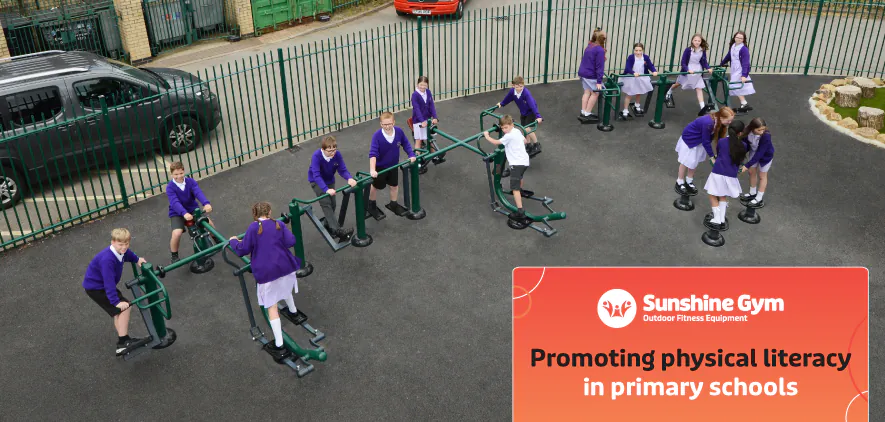Building positive attitudes to sport and activity is among the issues being tackled by Sport England.
And targeting children is one of the ways it believes it can encourage more people to stay active for longer.
Physical literacy – the concept of understanding the role of movement and activity in enriching life – is at the heart of this strategy.
Sport England says physically literate children and young people are more likely to be active and go on to engage in sports in the future.
There are currently about seven million children aged five to 15 in England, and more than half are reportedly not doing the recommended 60 minutes of daily exercise as recommended by the Chief Medical Officer.
Physical literacy in schools
At Sunshine Gym we believe in fitness for everybody and agree that it is never too early – or too late – to get moving.
That’s why we designed a range of outdoor gym equipment for children that is easy to operate, targets all over fitness and flexibility and is primarily lots of fun to use.
We see outdoor gyms in primary schools as a key tool to the development of a culture of physical literacy.
And from reading and interpreting the latest guidance from the Government relating to the spending of the PE and Sport Premium, we believe a focus on physical literacy will become increasingly relevant and important in education settings.
What is physical literacy?
Physical literacy is based around five elements – enjoyment, confidence, competence, understanding and knowledge.
The more elements present, the more physically literate a person is said to be and the more active they are likely to be.
Combined, these elements influence how physical activity is perceived and approached by individuals and it is seen as a concept which will contribute positively to the health and wellbeing of the population.
Sport England is now working with a number of universities to develop a consensus statement to provide a definition and explanation of what physical literacy is and why it is important.
Meanwhile the International Physical Literacy Association describes it as: “the motivation, confidence, physical competence, knowledge and understanding to value and take responsibility for engagement in physical activities for life.”
Going beyond PE lessons
Physical literacy as a concept was first proposed in 1993 by Margaret Whitehead, a leading researcher with a background in philosophy and physical education.
Her motivation is said to have included the general direction that physical education was taking and a growing drift away from physical activity as part of an everyday lifestyle.
In 2019 (pre-pandemic), Sport England focused its Active Lives Children and Young People Survey on the five elements of physical literacy.
At the time its findings showed:
- Enjoyment was the biggest driver of activity
- Physically literate children and young people are happier, more resilient and more trusting of other children and young people
- Physical literacy declines with age
Last year’s (2022) survey represents the first full year’s data following the removal of legal restrictions related to Covid-19.
It shows that physical literacy levels haven’t recovered to their pre-pandemic state and that fewer children ‘strongly agreed’ with each of the five attitudes.
It stands to reason then, that these indicators have possibly had some influence on a slight shift in the guidance relating to how schools can invest the PE and Sport Premium.
As it stands in April 2023, just as the final allocations are being made, the guidance has a strong focus on sustainability, delivering improvements that can be enjoyed by pupils now and in the future.
There is also a focus on quality which we feel directly links to the enjoyment factor and a directive that investments should engage all pupils as well as open up a broader range of activities to students.
These key indicators, together with a standard to improve the confidence, knowledge and skills of PE staff, seem to address the five strands of physical literacy.
Outdoor gyms to develop physical literacy
With such a broad range of equipment available, a Sunshine Gym is a comprehensive way to meet the Premium guidance as well as shape how schools approach physical literacy for pupils.
- Motivation – through inclusive designs such as our multi gyms, pupils of all ages and abilities can come together to motivate and encourage each other to work out and enjoy the feel-good factor that comes from exercise that will hopefully stay with them for life
- Confidence – easy to operate equipment, built to child-friendly dimensions, gives every pupil the opportunity to work out at their own pace and speed while building confidence as they recognise improvement in their performance
- Competence – delivering fun workouts each time, children want to return to their Sunshine Gym whether it is in PE lessons or during break and lunch times which helps to build competence
- Knowledge – with new tools at their disposal, an outdoor gym enables staff to improve their own knowledge and skills which is passed on to children
- Understanding – each piece of equipment features clear labelling on the aims and functions of the machine, helping children to learn how and why using the school outdoor gym improves fitness and the benefits that brings.
At Sunshine Gym we offer wheelchair accessible equipment, multi gyms, cardiovascular equipment and outdoor gym equipment for stretching and flexibility – we aim to provide fitness for everybody.
Get in touch today to discuss how a Sunshine Gym can support your primary schools physical literacy and PE aims.
